radiator TOYOTA tC 2011 Owners Manual (in English)
[x] Cancel search | Manufacturer: TOYOTA, Model Year: 2011, Model line: tC, Model: TOYOTA tC 2011Pages: 473, PDF Size: 10.91 MB
Page 272 of 473

272 4-2. Maintenance
General maintenance
Engine compartment
ItemsCheck points
Battery Check the connections.
(P. 296)
Brake fluid Is the brake fluid at the correct
level? (
P. 293)
Engine coolant Is the engine coolant at the cor-
rect level?
(P. 291)
Engine oil Is the engine oil at the correct
level?
(P. 286)
Exhaust system There should not be any fumes or
strange sounds.
Radiator/condenser The radiator and condenser
should be free from foreign
objects.
(P. 293)
Washer fluid Is there sufficient washer fluid?
(P. 300)
Listed below are the general maintenance items that should be per-
formed at the intervals specified in the “Owner’s Warranty Informa-
tion Booklet” or “Owner’s Manual Supplement/Scheduled
Maintenance Guide”. It is recommended that any problem you notice
should be brought to the attention of your Scion dealer or qualified
service shop for advice.
Page 279 of 473
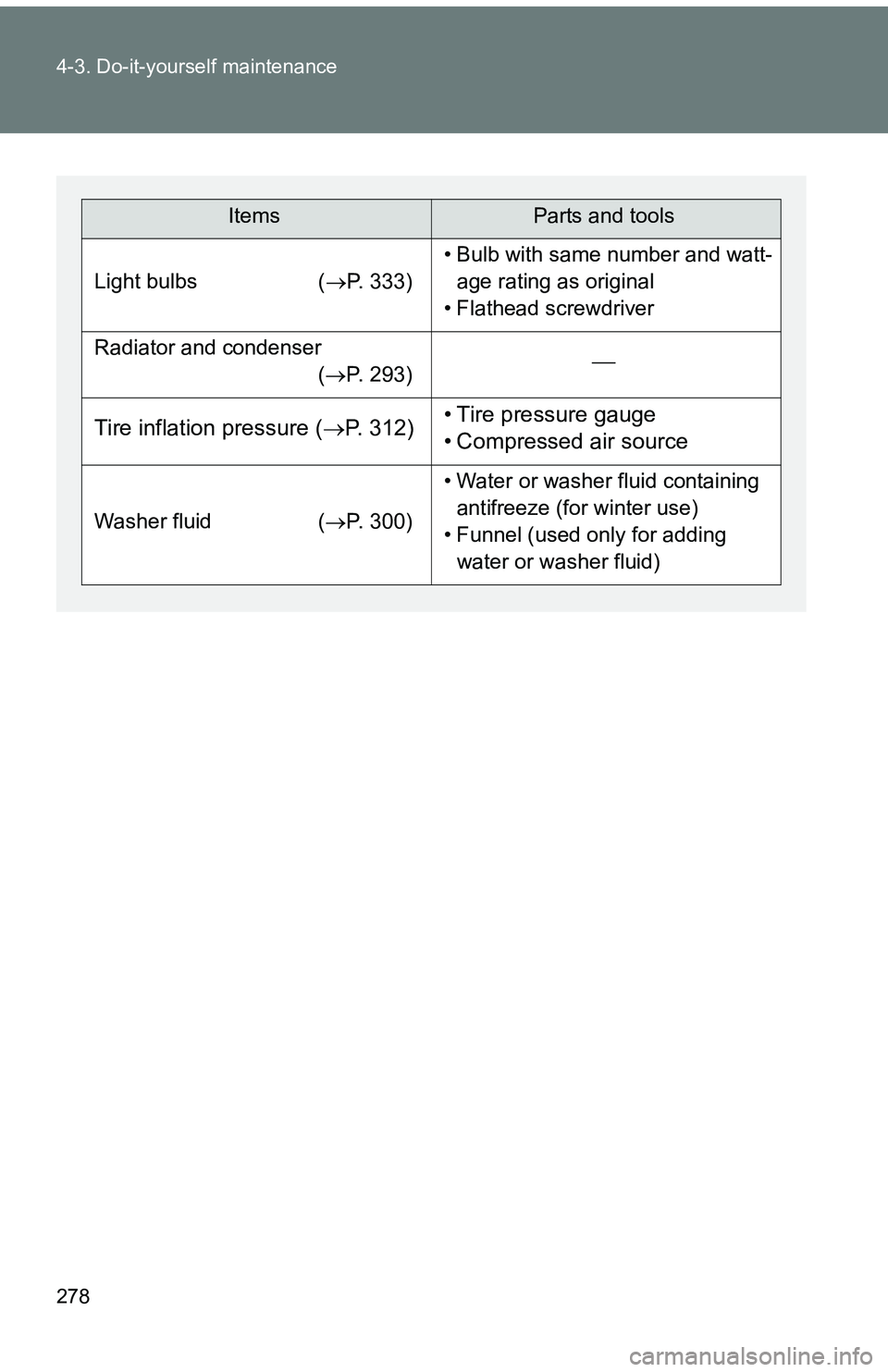
278 4-3. Do-it-yourself maintenance
ItemsParts and tools
Light bulbs (P. 333)
• Bulb with same number and watt-
age rating as original
• Flathead screwdriver
Radiator and condenser (P. 293)
Tire inflation pressure ( P. 312)• Tire pressure gauge
• Compressed air source
Washer fluid (P. 300)
• Water or washer fluid containing
antifreeze (for winter use)
• Funnel (used only for adding water or washer fluid)
Page 280 of 473
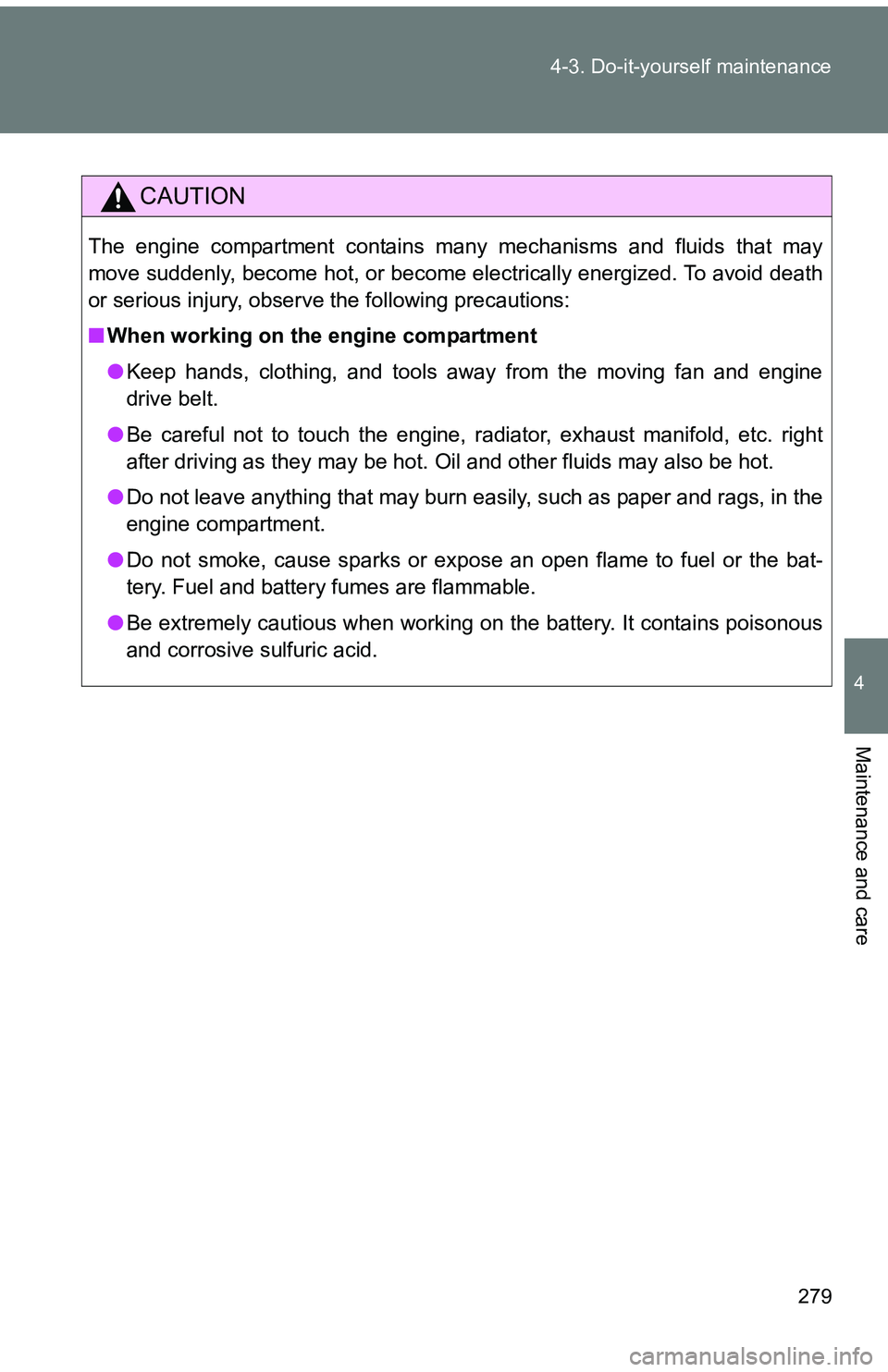
279
4-3. Do-it-yourself maintenance
4
Maintenance and care
CAUTION
The engine compartment contains many mechanisms and fluids that may
move suddenly, become hot, or become electrically energized. To avoid death
or serious injury, observe the following precautions:
■
When working on the engine compartment
●Keep hands, clothing, and tools away from the moving fan and engine
drive belt.
● Be careful not to touch the engine, radiator, exhaust manifold, etc. right
after driving as they may be hot. Oil and other fluids may also be hot.
● Do not leave anything that may burn easily, such as paper and rags, in the
engine compartment.
● Do not smoke, cause sparks or expose an open flame to fuel or the bat-
tery. Fuel and battery fumes are flammable.
● Be extremely cautious when working on the battery. It contains poisonous
and corrosive sulfuric acid.
Page 281 of 473
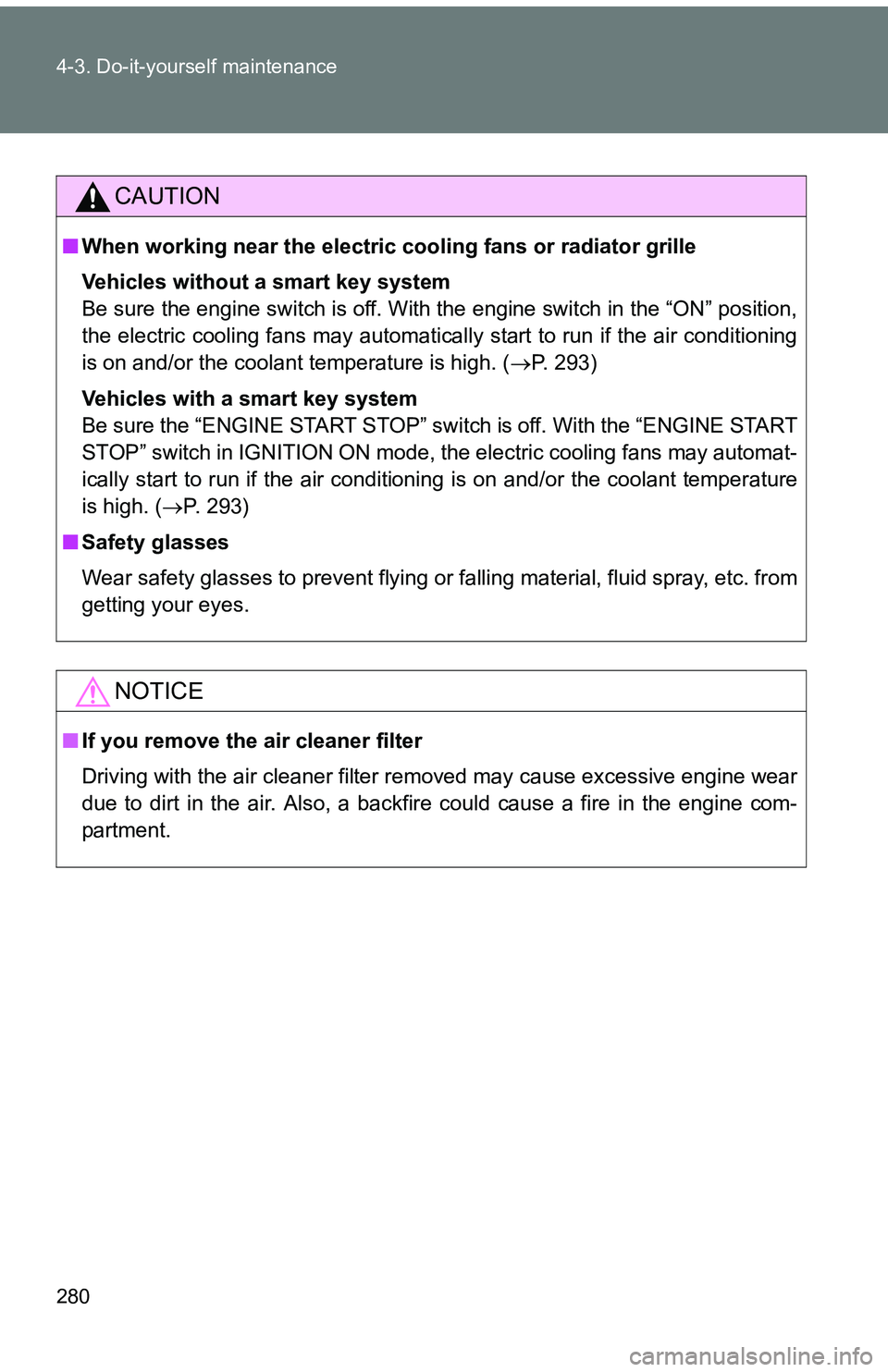
280 4-3. Do-it-yourself maintenance
CAUTION
■When working near the electric c ooling fans or radiator grille
Vehicles without a smart key system
Be sure the engine switch is off. With the engine switch in the “ON” position,
the electric cooling fans may automatically start to run if the air conditioning
is on and/or the coolant temperature is high. ( P. 293)
Vehicles with a smart key system
Be sure the “ENGINE START STOP” switch is off. With the “ENGINE START
STOP” switch in IGNITION ON mode, the electric cooling fans may automat\
-
ically start to run if the air conditioning is on and/or the coolant temperature
is high. ( P. 293)
■ Safety glasses
Wear safety glasses to prevent flying or falling material, fluid spray, etc. from
getting your eyes.
NOTICE
■If you remove the air cleaner filter
Driving with the air cleaner filter removed may cause excessive engine wear
due to dirt in the air. Also, a backfire could cause a fire in the engine com-
partment.
Page 286 of 473
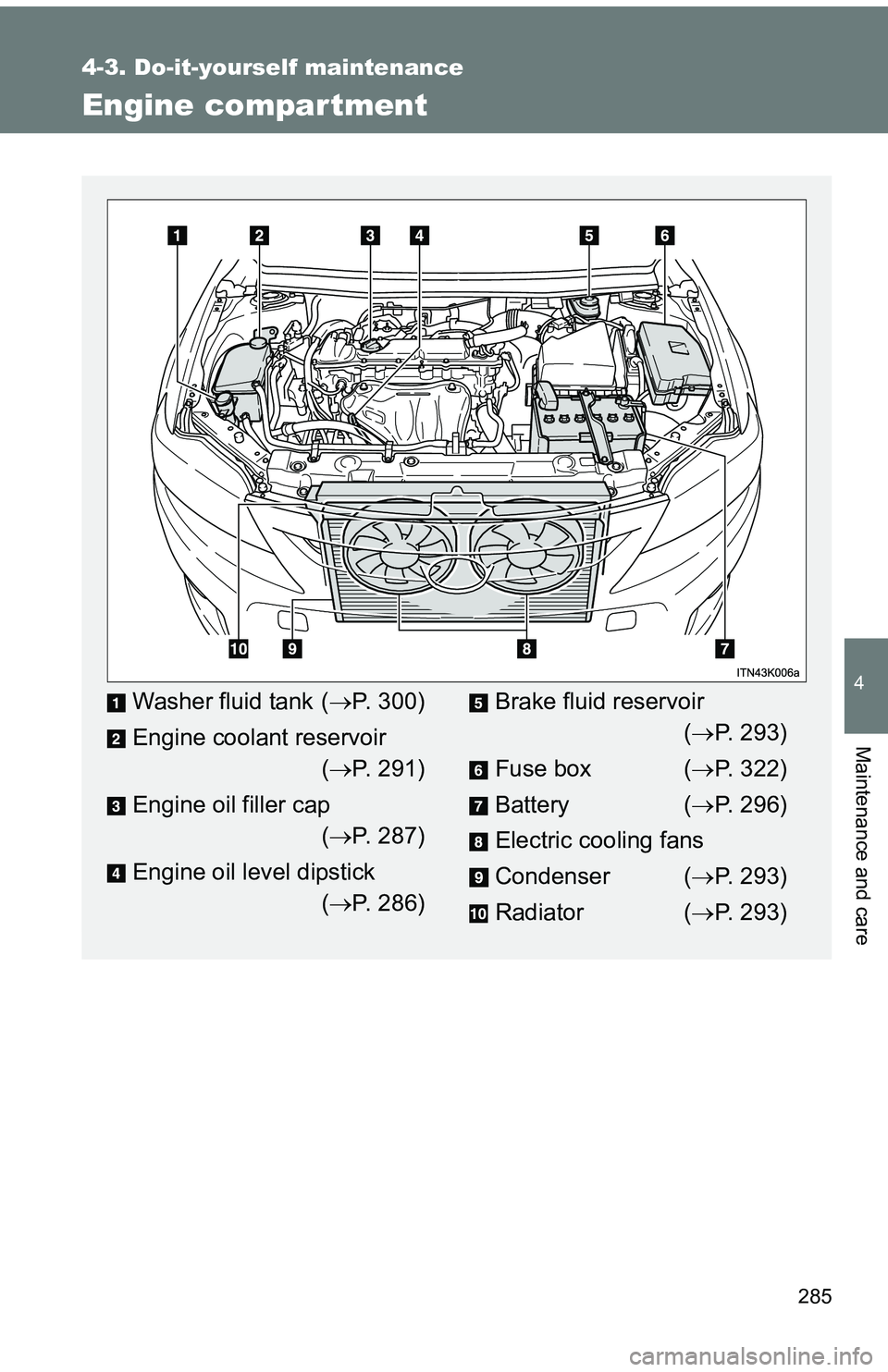
285
4-3. Do-it-yourself maintenance
4
Maintenance and care
Engine compar tment
Washer fluid tank (P. 300)
Engine coolant reservoir ( P. 291)
Engine oil filler cap ( P. 287)
Engine oil level dipstick ( P. 286)Brake fluid reservoir
( P. 293)
Fuse box ( P. 322)
Battery ( P. 296)
Electric cooling fans
Condenser ( P. 293)
Radiator ( P. 293)
Page 292 of 473
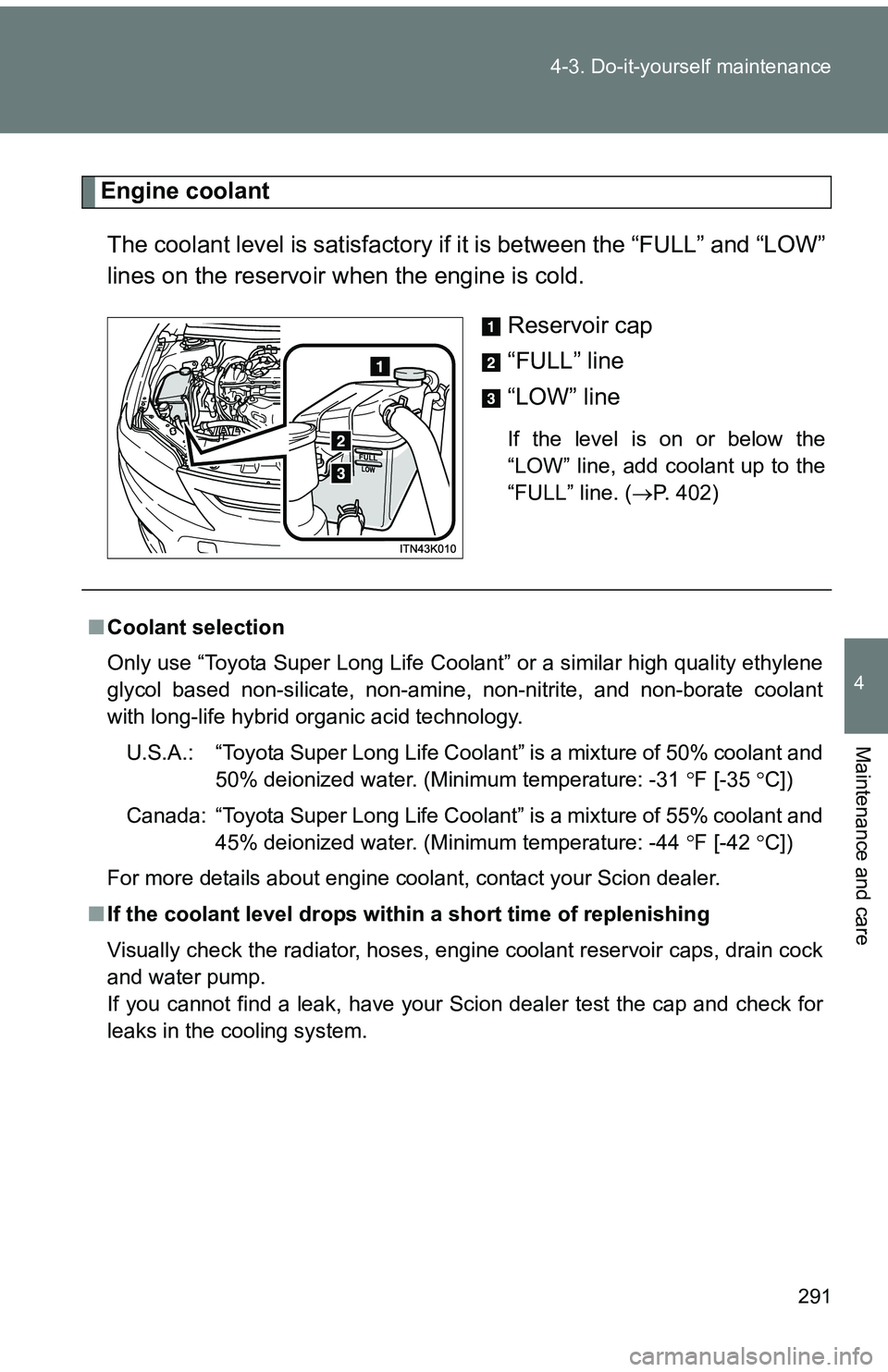
291
4-3. Do-it-yourself maintenance
4
Maintenance and care
Engine coolant
The coolant level is satisfactory if it is between the “FULL” and “LOW”
lines on the reservoir when the engine is cold.
Reservoir cap
“FULL” line
“LOW” line
If the level is on or below the
“LOW” line, add coolant up to the
“FULL” line. (P. 402)
■Coolant selection
Only use “Toyota Super Long Life Coolant” or a similar high quality ethylene
glycol based non-silicate, non-amine, non-nitrite, and non-borate coolant
with long-life hybrid organic acid technology.
U.S.A.: “Toyota Super Long Life Coolant” is a mixture of 50% coolant and 50% deionized water. (Minimum temperature: -31 F [-35 C])
Canada: “Toyota Super Long Life Coolant” is a mixture of 55% coolant and 45% deionized water. (Minimum temperature: -44 F [-42 C])
For more details about engine coolant, contact your Scion dealer.
■ If the coolant level drops within a short time of replenishing
Visually check the radiator, hoses, engine coolant reservoir caps, drain cock
and water pump.
If you cannot find a leak, have your Scion dealer test the cap and check for
leaks in the cooling system.
Page 294 of 473
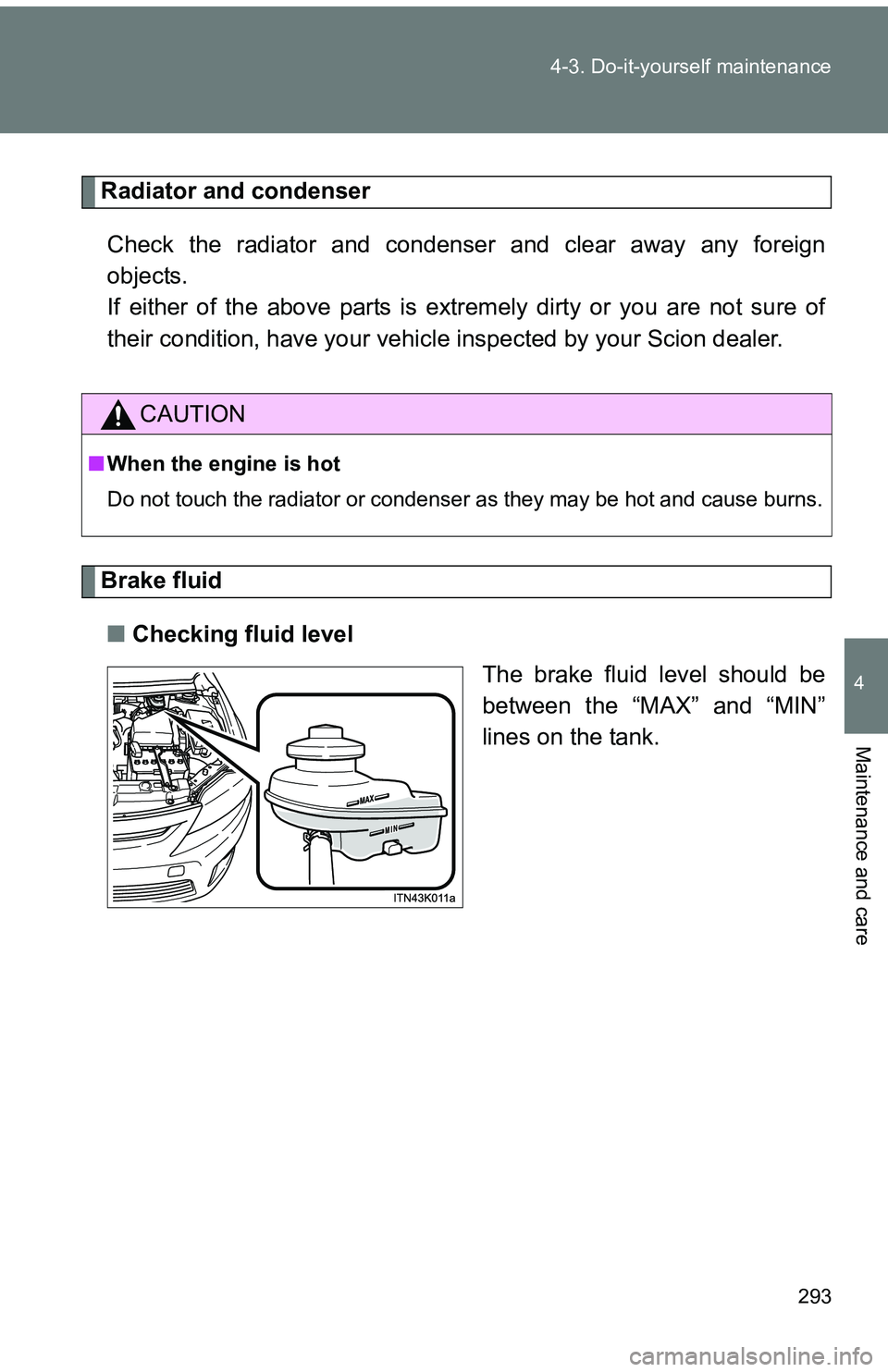
293
4-3. Do-it-yourself maintenance
4
Maintenance and care
Radiator and condenser
Check the radiator and condenser and clear away any foreign
objects.
If either of the above parts is extremely dirty or you are not sure of
their condition, have your vehicl e inspected by your Scion dealer.
Brake fluid
■ Checking fluid level
The brake fluid level should be
between the “MAX” and “MIN”
lines on the tank.
CAUTION
■When the engine is hot
Do not touch the radiator or condenser as they may be hot and cause burn\
s.
Page 403 of 473
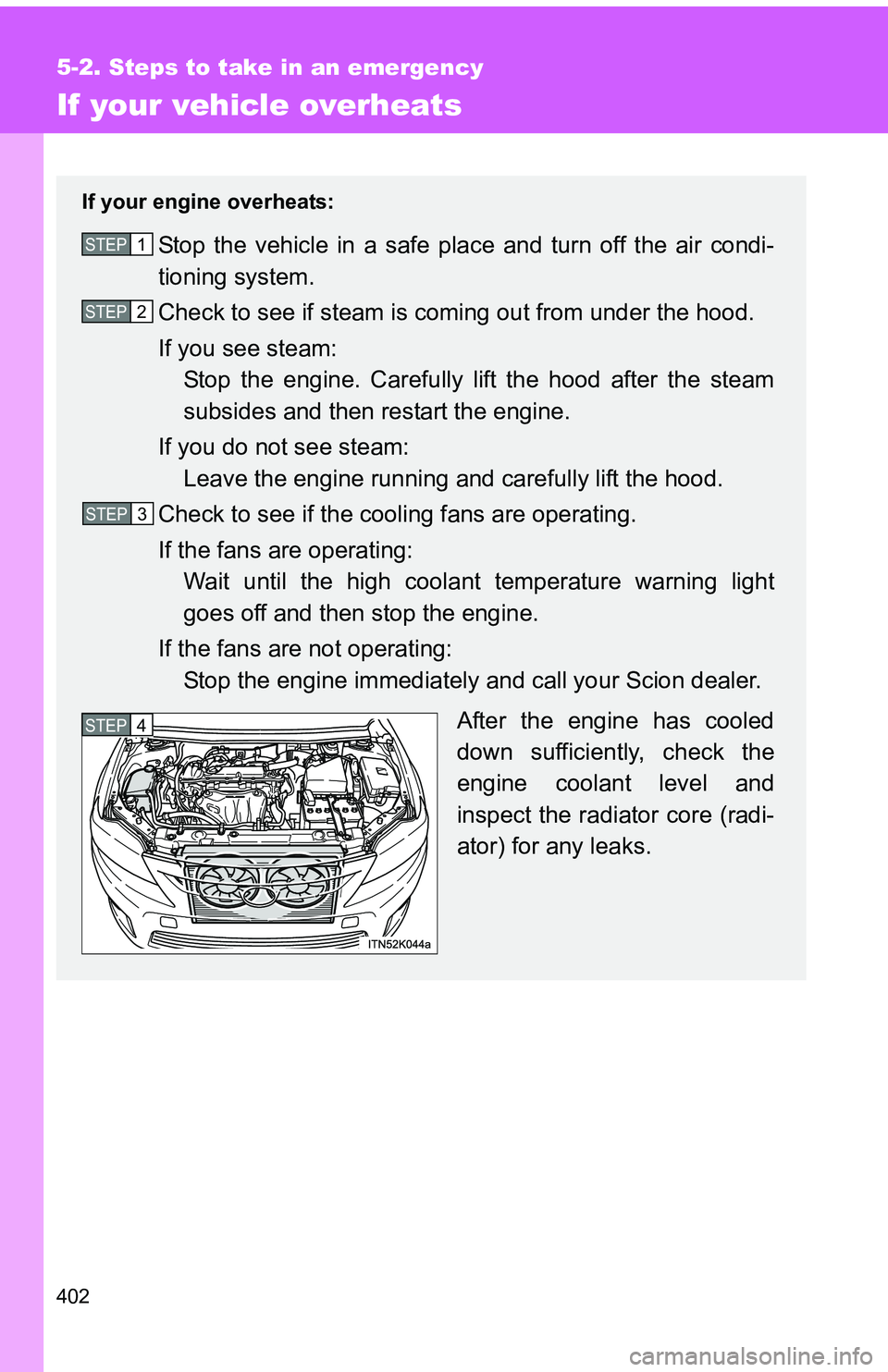
402
5-2. Steps to take in an emergency
If your vehicle overheats
If your engine overheats:
Stop the vehicle in a safe place and turn off the air condi-
tioning system.
Check to see if steam is coming out from under the hood.
If you see steam: Stop the engine. Carefully lift the hood after the steam
subsides and then restart the engine.
If you do not see steam: Leave the engine running and carefully lift the hood.
Check to see if the cooling fans are operating.
If the fans are operating: Wait until the high coolant temperature warning light
goes off and then stop the engine.
If the fans are not operating: Stop the engine immediately and call your Scion dealer.
After the engine has cooled
down sufficiently, check the
engine coolant level and
inspect the radiator core (radi-
ator) for any leaks.STEP 1
STEP 2
STEP 3
STEP 5 STEP 4
Page 405 of 473
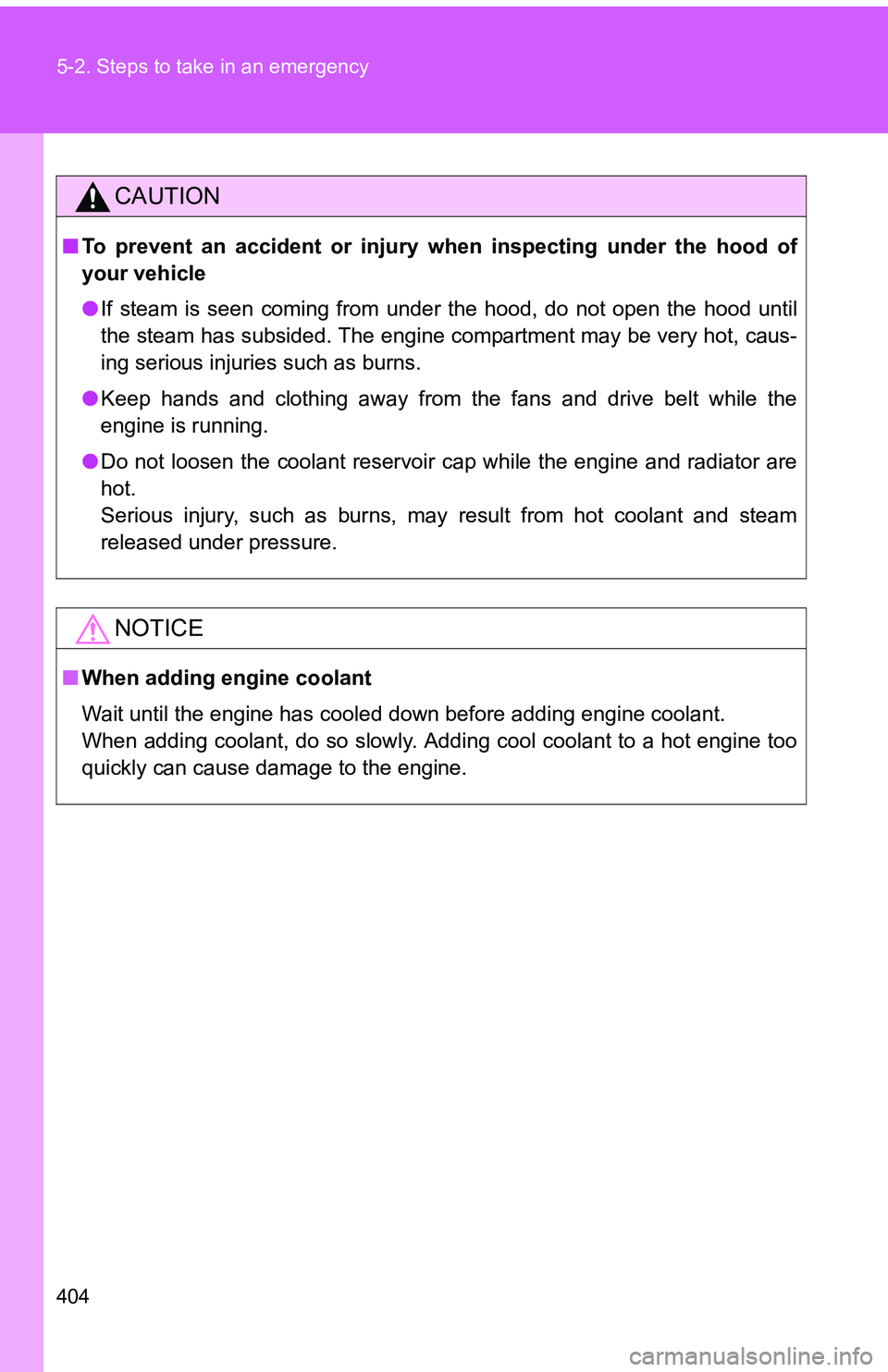
404 5-2. Steps to take in an emergency
CAUTION
■To prevent an accident or injury when inspecting under the hood of
your vehicle
● If steam is seen coming from under the hood, do not open the hood until
the steam has subsided. The engine compartment may be very hot, caus-
ing serious injuries such as burns.
● Keep hands and clothing away from the fans and drive belt while the
engine is running.
● Do not loosen the coolant reservoir cap while the engine and radiator are
hot.
Serious injury, such as burns, may result from hot coolant and steam
released under pressure.
NOTICE
■When adding engine coolant
Wait until the engine has cooled down before adding engine coolant.
When adding coolant, do so slowly. Adding cool coolant to a hot engine too
quickly can cause damage to the engine.
Page 464 of 473
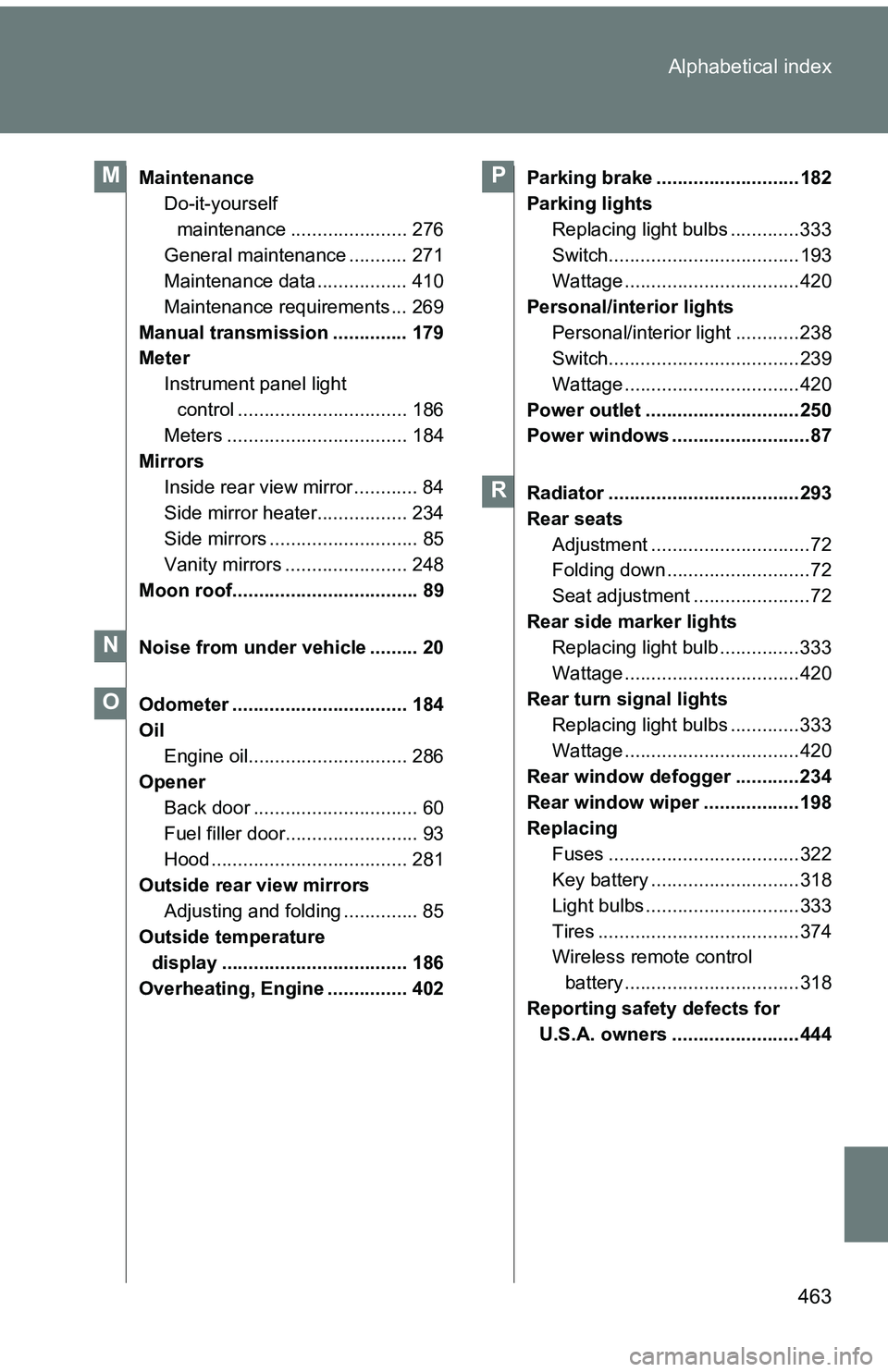
463
Alphabetical index
Maintenance
Do-it-yourself
maintenance ...................... 276
General maintenance ........... 271
Maintenance data ................. 410
Maintenance requirements ... 269
Manual transmission .............. 179
Meter Instrument panel light control ................................ 186
Meters .................................. 184
Mirrors Inside rear view mirror ............ 84
Side mirror heater................. 234
Side mirrors ............................ 85
Vanity mirrors ....................... 248
Moon roof................................... 89
Noise from under vehicle ......... 20
Odometer ................................. 184
Oil
Engine oil.............................. 286
Opener
Back door ............................... 60
Fuel filler door......................... 93
Hood ..................................... 281
Outside rear view mirrors Adjusting and folding .............. 85
Outside temperature
display ................................... 186
Overheating, Engine ............... 402 Parking brake ...........................182
Parking lights
Replacing light bulbs .............333
Switch....................................193
Wattage .................................420
Personal/interior lights Personal/interior light ............238
Switch....................................239
Wattage .................................420
Power outlet .............................250
Power windows ..........................87
Radiator ....................................293
Rear seats Adjustment ..............................72
Folding down ...........................72
Seat adjustment ......................72
Rear side marker lights Replacing light bulb ...............333
Wattage .................................420
Rear turn signal lights Replacing light bulbs .............333
Wattage .................................420
Rear window defogger ............234
Rear window wiper ..................198
Replacing Fuses ....................................322
Key battery ............................318
Light bulbs .............................333
Tires ......................................374
Wireless remote control battery .................................318
Reporting safety defects for U.S.A. owners ........................444M
N
O
P
R